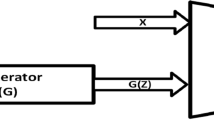Abstract
Over the past few years, with the introduction of deep learning techniques such as convolution neural network (CNN), supervised learning with CNN had achieved a huge success in the computer vision area such as classifying digital images. However, supervised learning has a major drawback, in which it requires a large dataset for them to perform more effectively. As the data used in training grew bigger, the cost of labeling data for training becomes more expensive and impractical. In order to resolve this issue, unsupervised learning is encouraged to be used as it can draw inferences from datasets consisting of unlabeled input data. Generative adversarial network (GAN) is one of the unsupervised learning technique that has the ability to create natural-looking images, converting text description into images, recover resolution of images and last but not least, its power of representation learning from unlabeled data. Thus, this study attempts to evaluate the effectiveness of GAN algorithm in performing the supervised task and unsupervised task such as classification and clustering. Based on the results obtained, the GAN algorithm can learn the internal representation of data without labels and can act as good features extractor. Future works include applying GAN framework in other domains such as video, natural language processing and text to image synthesis.
Access this chapter
Tax calculation will be finalised at checkout
Purchases are for personal use only
Similar content being viewed by others
References
O. Russakovsky, J. Deng, H. Su, J. Krause, S. Satheesh, S. Ma, Z. Huang, A. Karpathy, A. Khosla, M. Bernstein, A.C. Berg, ImageNet large scale visual recognition challenge. Int. J. Comput. Vis. 115(3), 211–252 (2015)
E.A. Hay, R. Parthasarathy, Performance of convolutional neural networks for identification of bacteria in 3D microscopy datasets. PLoS Comput. Biol. 14(12), e1006628 (2018). https://doi.org/10.1371/journal.pcbi.1006628
W. Rawat, Z. Wang, Deep convolutional neural networks for image classification: a comprehensive review. Neural Comput. 29, 2352–2449 (2017)
I.J. Goodfellow, J. Pouget-Abadie, M. Mirza, B. Xu, D. Warde-Farley, S. Ozair, A. Courville, Y. Bengio, Generative adversarial nets. Adv. Neural Inf. Process. Syst. 2672–2680 (2014)
V. Premachandran, A.L. Yuille, Unsupervised learning using generative adversarial training and clustering, in Proceedings of the International Conference on Learning Representations (ICLR), Toulon, France, 24–26 April 2017
X. Chen, Y. Duan, R. Houthooft, J. Schulman, I. Sutskever, P. Abbeel, InfoGAN: interpretable representation learning by information maximizing generative adversarial nets. Adv. Neural Inf. Process. Syst. 2172–2180 (2016)
X. Mao, et al., Least squares generative adversarial networks, in 2017 IEEE International Conference on Computer Vision (ICCV) (IEEE, 2017)
J.T. Springenberg, Unsupervised and semi-supervised learning with categorical generative adversarial networks. arXiv preprint arXiv:1511.06390 (2016)
M. Arjovsky, S. Chintala, L. Bottou, Wasserstein GAN. arXiv preprint arXiv:1701.07875 (2017)
A. Coates, H. Lee, A.Y. Ng, An analysis of single layer networks in unsupervised feature learning, in AISTATS, 2011
Y. Koshiba, S. Abe, Comparison of L1 and L2 support vector machines, in Proceedings of the International Joint Conference on Neural Networks, 2003, vol. 3 (IEEE, 2003), pp. 2054–2059
Y. Tang, Deep learning using support vector machines. CoRR, abs/1306.0239, 2013
T. Salimans, I. Goodfellow, W. Zaremba, V. Cheung, A. Radford, X. Chen, Improved techniques for training GANs, in Advances in Neural Information Processing Systems (2016), pp. 2234–2242
Author information
Authors and Affiliations
Corresponding author
Editor information
Editors and Affiliations
Rights and permissions
Copyright information
© 2020 Springer Nature Singapore Pte Ltd.
About this paper
Cite this paper
Alfred, R., Lun, C.Y. (2020). Unsupervised Learning of Image Data Using Generative Adversarial Network. In: Yang, XS., Sherratt, S., Dey, N., Joshi, A. (eds) Fourth International Congress on Information and Communication Technology. Advances in Intelligent Systems and Computing, vol 1041. Springer, Singapore. https://doi.org/10.1007/978-981-15-0637-6_10
Download citation
DOI: https://doi.org/10.1007/978-981-15-0637-6_10
Published:
Publisher Name: Springer, Singapore
Print ISBN: 978-981-15-0636-9
Online ISBN: 978-981-15-0637-6
eBook Packages: EngineeringEngineering (R0)




